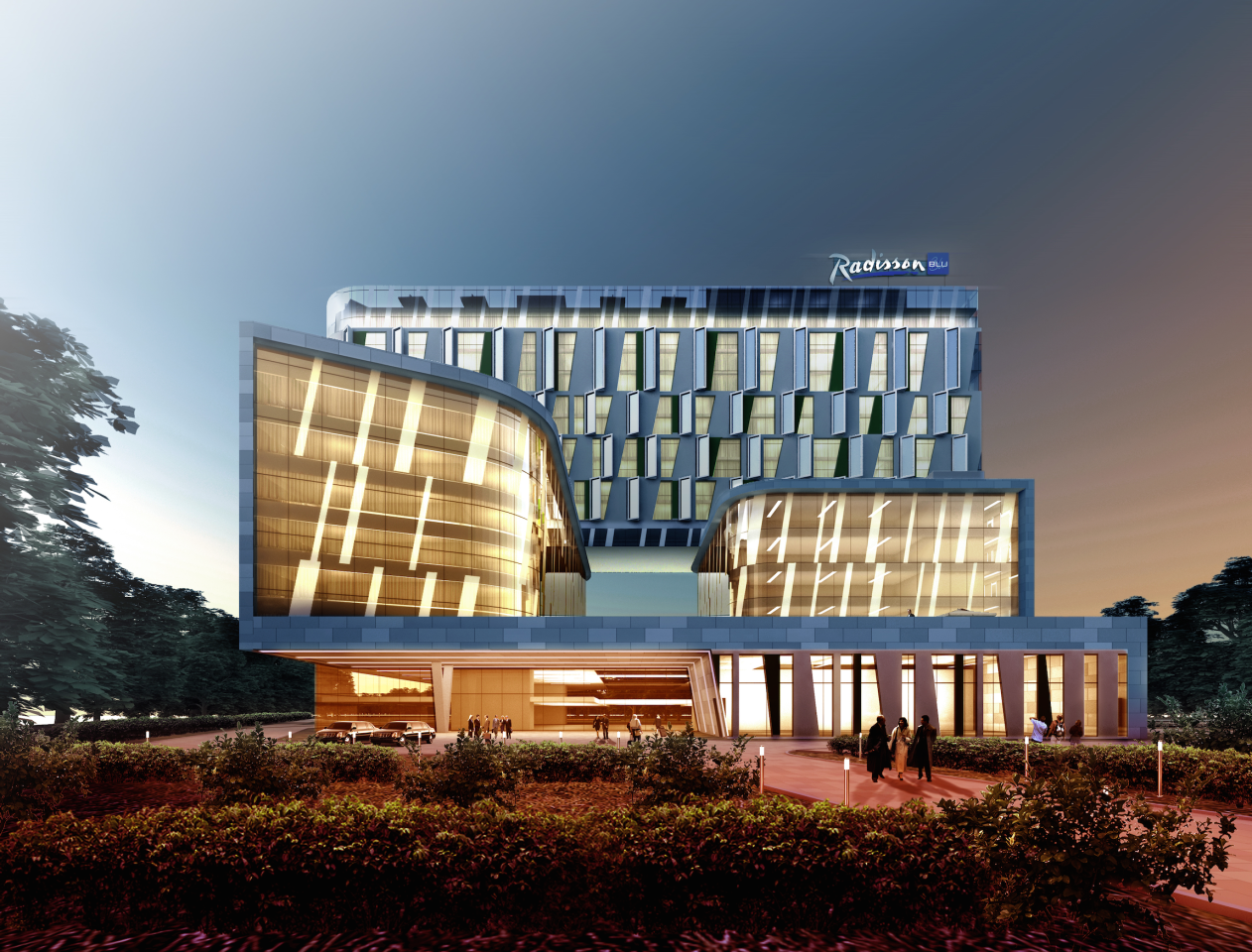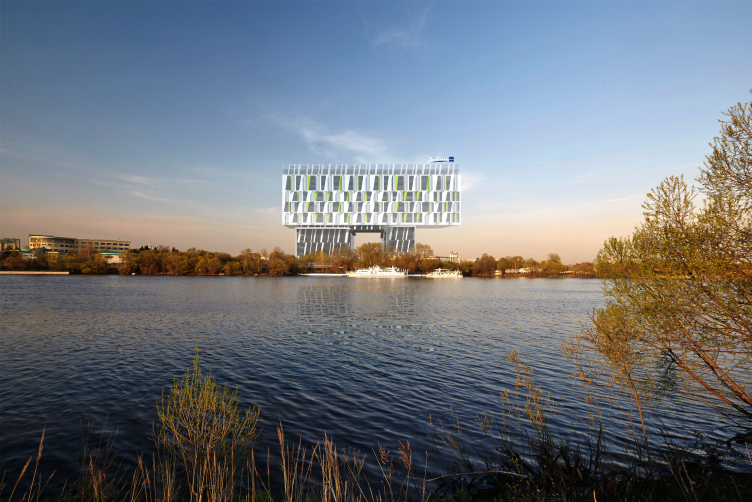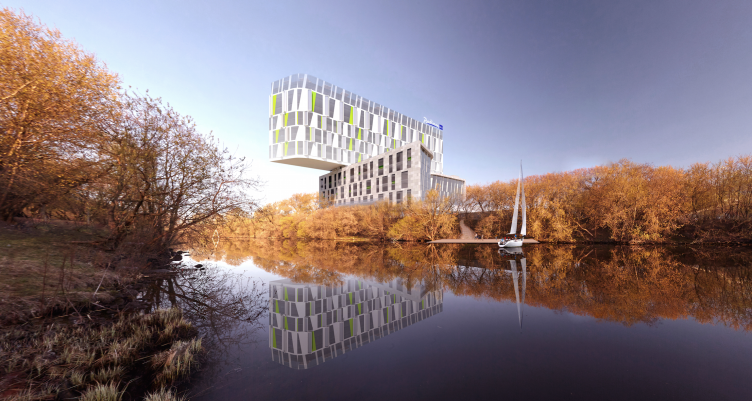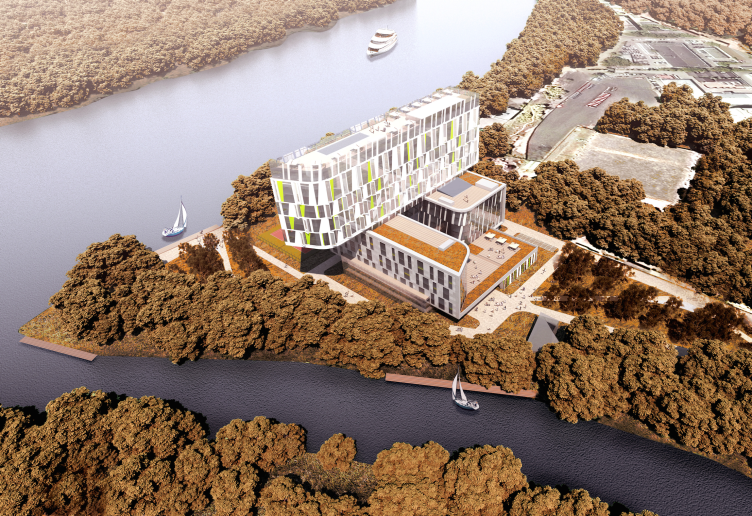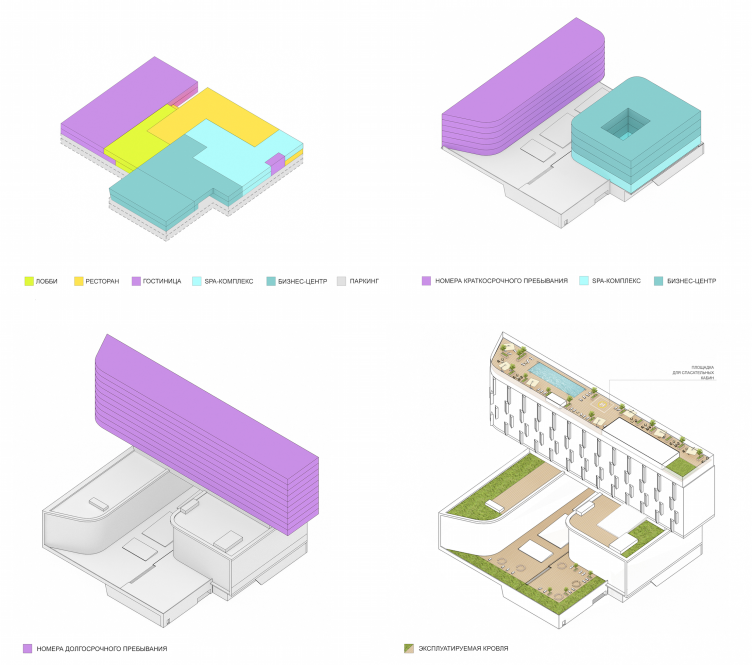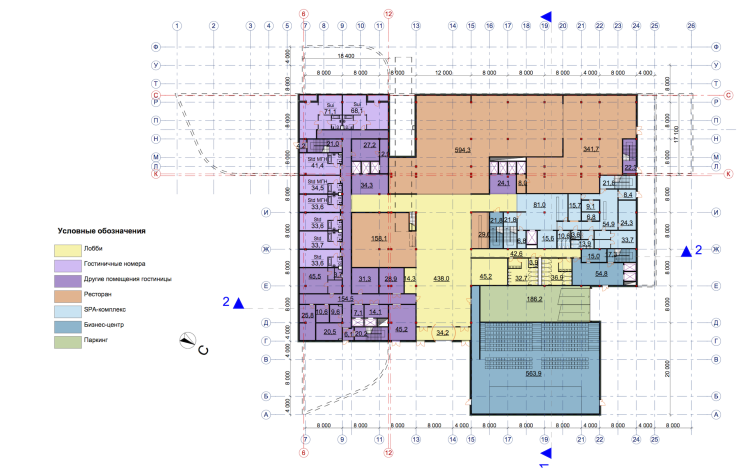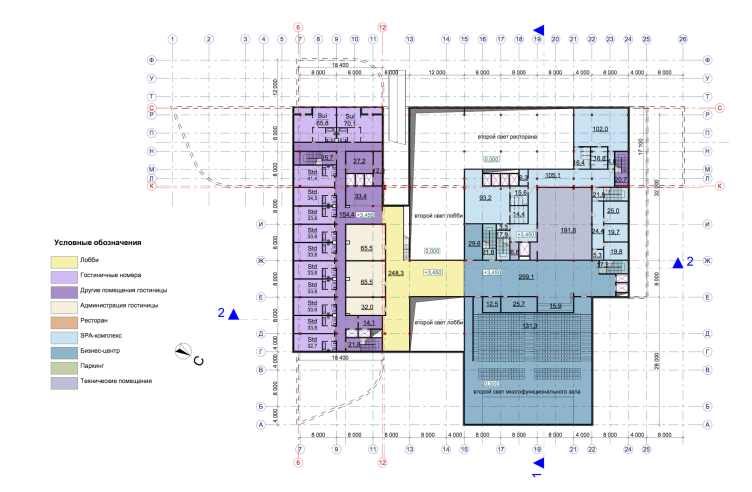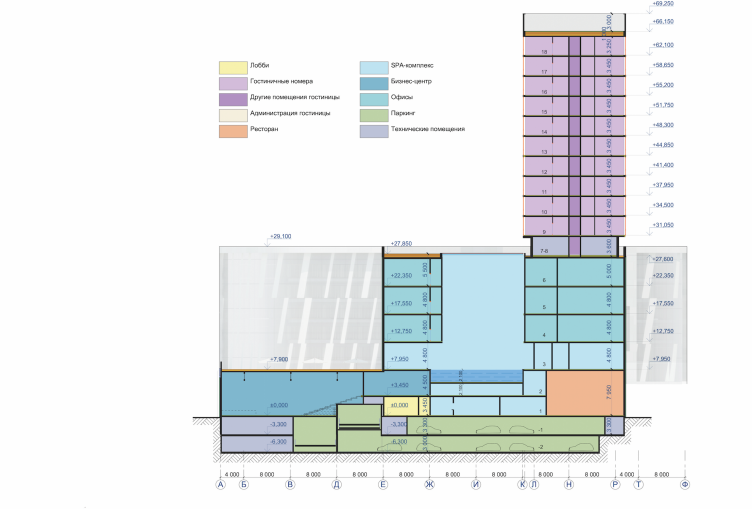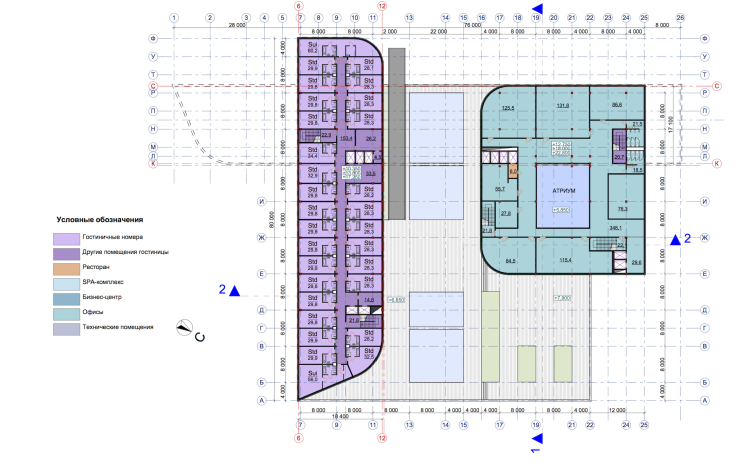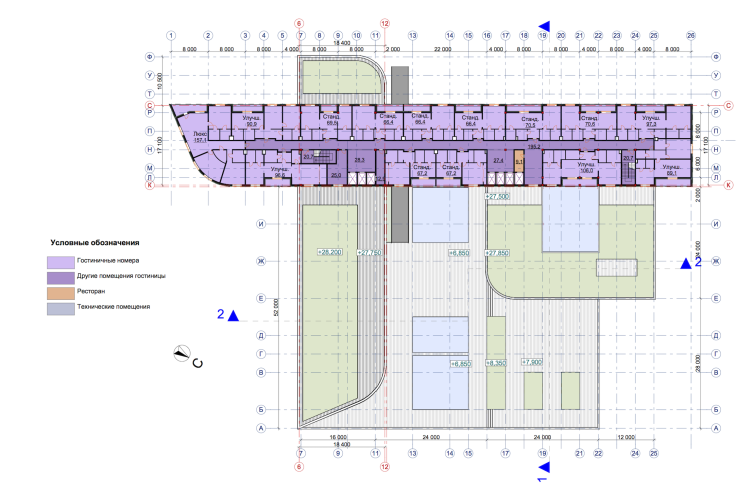Continuing the review of the results of the best concept contest for Radisson Blue Moscow Riverside Hotel, we are featuring the joint project of Polyansky Institute of Architecture, GrandProjectCity, and Asadov Architectural Bureau. The judging panel did not include it into the leading three list - but the dramatic architectural image proposed by the consortium could have easily become an impressive centerpiece of this picturesque land, advantageous in all respect, lying in the confluence of the Moskva and Skhodnya rivers.
According to the rules and conditions of the contest, one of the main evaluation criteria was "conformity to the requirements of Radisson Blu chain". And this is by no means a formality: Carlson Rezidor Group that owns the brand traditionally sets forth the most rigorous requirements to the architecture and design of its hotels, be that a reconstruction or building something from scratch. Enumerating all these world-famous hotels of this chain would result in a quite a long list, so here are but a few names that immediately come to mind: Copenhagen's Radisson Blu, for instance, was designed by Arne Jacobsen, in Berlin - by Sergey Tchoban, in Moscow and Chelyabinsk - by Christian Lundwall, in Batumi - by Michele De Lucchi, in Belgrade, "Graft Architects" did a brilliant project of renovating a XIX century factory building, the hotel in Nant was done by Jean-Phillip Nouelle... Nobody is talking about any stylistic unity here - just about the level to which the bar has been raised. Just another reason not to limit oneself in the means of plastic expression in order to create a truly interesting project.
The hotel - the only tall building for miles around - will be perfectly viewable from lots of different angles - which provides for the architects a rare-for-urban-environment opportunity to play with these angles. The authors of this project used this opportunity to the fullest: depending on the viewing angle, the building looks so different that combining these pictures in one's mind's eye might be quite a stretch. "The basic screen of the main building is oriented to the Moskva River and its farther vantage points" - Karen Saprichyan explains. From the opposite bank, across the river's great wide open, the building resembles a giant megalith that was brought to the nation's capital by winds unknown and then all covered with a mysterious barcode. Then we pass around (or swim around, or, better yet, fly around the cape) - and the complex gradually takes shape, the shadow from the giant cantilever falling down askew on the "supporting" block adding diagonals to the array of elongated window apertures (yet another barcode, only monochrome this time). Continuing this imaginary tour, we find ourselves in front of the eastern facade - only at this point the trees step to the sides allowing us to see the main entrance and the roofed area in front of it, the rounded corners of the side volumes sucking us inside the complex like a giant whirlpool, and then even further through it - where through the square opening one can finally see "a piece of heaven".
RADISSON BLU MOSCOW RIVERSIDE HOTEL&SPA © Asadov Architectural Bureau; GrandProjectCity; Polyansky Institute of Architecture
RADISSON BLU MOSCOW RIVERSIDE HOTEL&SPA © Asadov Architectural Bureau; GrandProjectCity; Polyansky Institute of Architecture
RADISSON BLU MOSCOW RIVERSIDE HOTEL&SPA © Asadov Architectural Bureau; GrandProjectCity; Polyansky Institute of Architecture
RADISSON BLU MOSCOW RIVERSIDE HOTEL&SPA © Asadov Architectural Bureau; GrandProjectCity; Polyansky Institute of Architecture
If we are to examine the complex building by building, there are four of them, the main one being a broad rectangular slab that rests in an even somewhat sloppy fashion on two others, these two resting on a broad two-story stylobate. The stylobate is also not quite "solid body", though: from the direction of the main entrance part of the volume is "taken away", which results in a spacious covered square. Practically invisible from any more or less significant distance because of its disadvantageous proportions and the surrounding verdure, the stylobate plays the crucial part of the "invisible hero": it not only serves as the basis for the "pyramid" holding its flashier brothers on its shoulders but also provides a whole lot of other key functions.
RADISSON BLU MOSCOW RIVERSIDE HOTEL&SPA © Asadov Architectural Bureau; GrandProjectCity; Polyansky Institute of Architecture
RADISSON BLU MOSCOW RIVERSIDE HOTEL&SPA © Asadov Architectural Bureau; GrandProjectCity; Polyansky Institute of Architecture
If we are to look at the plans of the first two floors, we will see that, besides a double-height lobby, it also includes a business center, a multifunctional hall, a restaurant (also double-height, commanding a fine view of the Moskva River), a spa center, numerous services, and even some of the hotel rooms. The swimming pool of the spa center is an important composition center: it gets surrounded by the walls of a four-story glazed atrium, along the perimeter of which offices are situated while on its eastern side it opens up to the roof of the stylobate, this roof performing, besides its direct function, a number of other responsible tasks: it carries a rather large public zone, along its ramp located at the back facade, emergency vehicles can ascend it, while on its southeast corner the roof blends into the marquee overhanging above the entrance square.
RADISSON BLU MOSCOW RIVERSIDE HOTEL&SPA. Plan of the first floor © Asadov Architectural Bureau; GrandProjectCity; Polyansky Institute of Architecture
RADISSON BLU MOSCOW RIVERSIDE HOTEL&SPA. Plan of the second floor © Asadov Architectural Bureau; GrandProjectCity; Polyansky Institute of Architecture
The building that is turned southward, to the Skhodnya River, on the plan looks like an elongated rectangle with one of its corners rounded out. This block contains the short-stay hotel rooms that take up all the six floors (counting from the ground level, from the third to the eighth). The other "support" given to the offices and the spa center is closer to a quadrant on the plan; by elevating the floors, with the same absolute height, the number of floors here is it four, and they all are placed around the already-mentioned atrium.
The main block - a ten-story slab, also rounded at its southeast corner - contains the apartments. For all its massiveness, it does not look "heavyweight" at all: the arch window between 21x21 meter supports makes the structure look almost ethereal. Besides, the trapeze-shaped windows and the bay windows with colored inserts create quite a convincing optical effect curtailing the number of floors from ten to four (experimenting with color is one of the signature techniques of Asadov Bureau). Such a solution, different from the more reserved lines of the stylobate part, was deliberately chosen: this allowed the architects to play on the contrasts of different architectural techniques.
RADISSON BLU MOSCOW RIVERSIDE HOTEL&SPA. Section view © Asadov Architectural Bureau; GrandProjectCity; Polyansky Institute of Architecture
RADISSON BLU MOSCOW RIVERSIDE HOTEL&SPA © Asadov Architectural Bureau; GrandProjectCity; Polyansky Institute of Architecture
The authors of the project elaborated in great detail (even, according to Karen Saprichyan, in too much detail by contest project standards) the design of the inside premises - both hotel rooms and offices. As for the latter, they are planned at four different levels: the entrance square, some areas on the roof of the stylobate and the hotel block, and the most striking one commanding magnificent views - on the roof of the main building with a swimming pool, a recreation area, and a helicopter landing. Oh, by the way, about the "cyber circular flight" around the complex - if we are to go through with unleashing our fantasy, you cannot think of a better place to end the guided tour.
RADISSON BLU MOSCOW RIVERSIDE HOTEL&SPA. Section view © Asadov Architectural Bureau; GrandProjectCity; Polyansky Institute of Architecture
RADISSON BLU MOSCOW RIVERSIDE HOTEL&SPA. Plan of the 4-6 floors © Asadov Architectural Bureau; GrandProjectCity; Polyansky Institute of Architecture
RADISSON BLU MOSCOW RIVERSIDE HOTEL&SPA. Plan of the 9-18 floors © Asadov Architectural Bureau; GrandProjectCity; Polyansky Institute of Architecture
